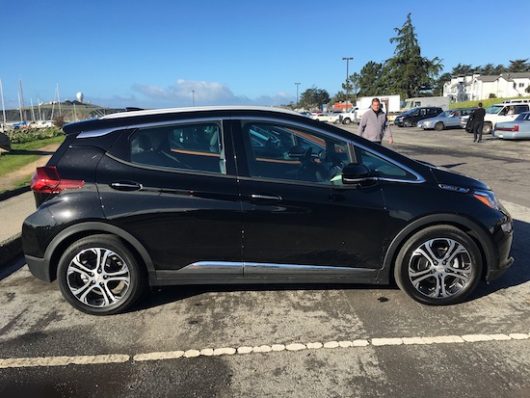Chevrolet Bolt EV Surprises – Range Anxiety Gone
- January 27, 2017
- Chevrolet, New Model Introductions, On The Road: Driving Impressions, Technology & New Features
- Posted by George Peterson
- Comments Off on Chevrolet Bolt EV Surprises – Range Anxiety Gone
When a Chevrolet manager refers to the Chevrolet Volt plug-in hybrid, they inevitably hold up two fingers to guarantee you know they are referring to the Volt. When they mention the Chevrolet Bolt EV electric vehicle, they always say “Bolt EV”. “Bolt EV did well in focus groups,” one PR manager stated. Having done thousands of focus groups over the years, I know how that can be done.
Well, enough of that. The Chevrolet Bolt EV is the real deal. It is an electric vehicle purpose-built around a five module battery pack that forms the floor of the car. These batteries give a maximum range of 238 miles. AutoPacific’s research on electric vehicles over the years has concluded that the holy grail for EV range is 225 miles to avoid range anxiety. So Bolt EV achieves that range with a little to spare.
The designed-in-South Korea Bolt EV is a crossover SUV in Chevrolet’s mind. I see it as more of a 5-door hatchback, but Chevrolet contends its higher seating position and relatively high roof deserve a crossover classification. Besides, crossovers are selling like hotcakes these days and cars are not. Bolt EV looks modern with forward sloping character lines that you could see on a crossover today. OK, it’s a crossover.
The Bolt EV is spacious enough for four people. Getting in and out is relatively easy but the front A-Pillars are so fast that you have to be careful to duck or else you will hit your head. The instrument panel in the top model includes a reconfigurable instrument cluster and a 10.2 inch screen in the center stack that provides all the information concerning its electric operation and the usual connectivity features like Bluetooth. Apple CarPlay and Android Auto are how you get navigation in the car. There is no resident NAV. The Bolt EV is available with the typical General Motors driver assistance features like adaptive cruise control, lane keeping assist, lane keeping warning, surround view camera, blind spot warning, etc.
The real surprise comes when driving the Bolt EV. Its powerpack provides 200-horsepower and 266 lb-ft of torque. This output is like a peppy 1.6L or 1.8L turbo 4-cylinder in a hot hatch small car. Bolt EV does not have to apologize to anyone on the freeway. The car can be operated in “one-foot mode” where regenerative braking is activated. This would be my normal driving mode. When you lift off the accelerator, the brakes engage to put electricity back into the batteries. The deceleration can be controlled by a paddle behind the steering wheel. Using regen, you rarely have to actually press on the brake pedal.
No new car is perfect and the Bolt EV is not. Where it falls down is in the material selection in the interior. Lots of hard, glossy plastic. The lightweight front seats are very hard and the side bolsters are stiff.
The base price of the Bolt EV is $37,495 that results in a $29,995 price after the federal government tax credit (you have to earn about $75,000 to qualify for that tax credit). If you load the Bolt EV up with all the options, it will top out at around $44,000.
Bolt is on sale now in California and Oregon and will roll out nationally over the year.


